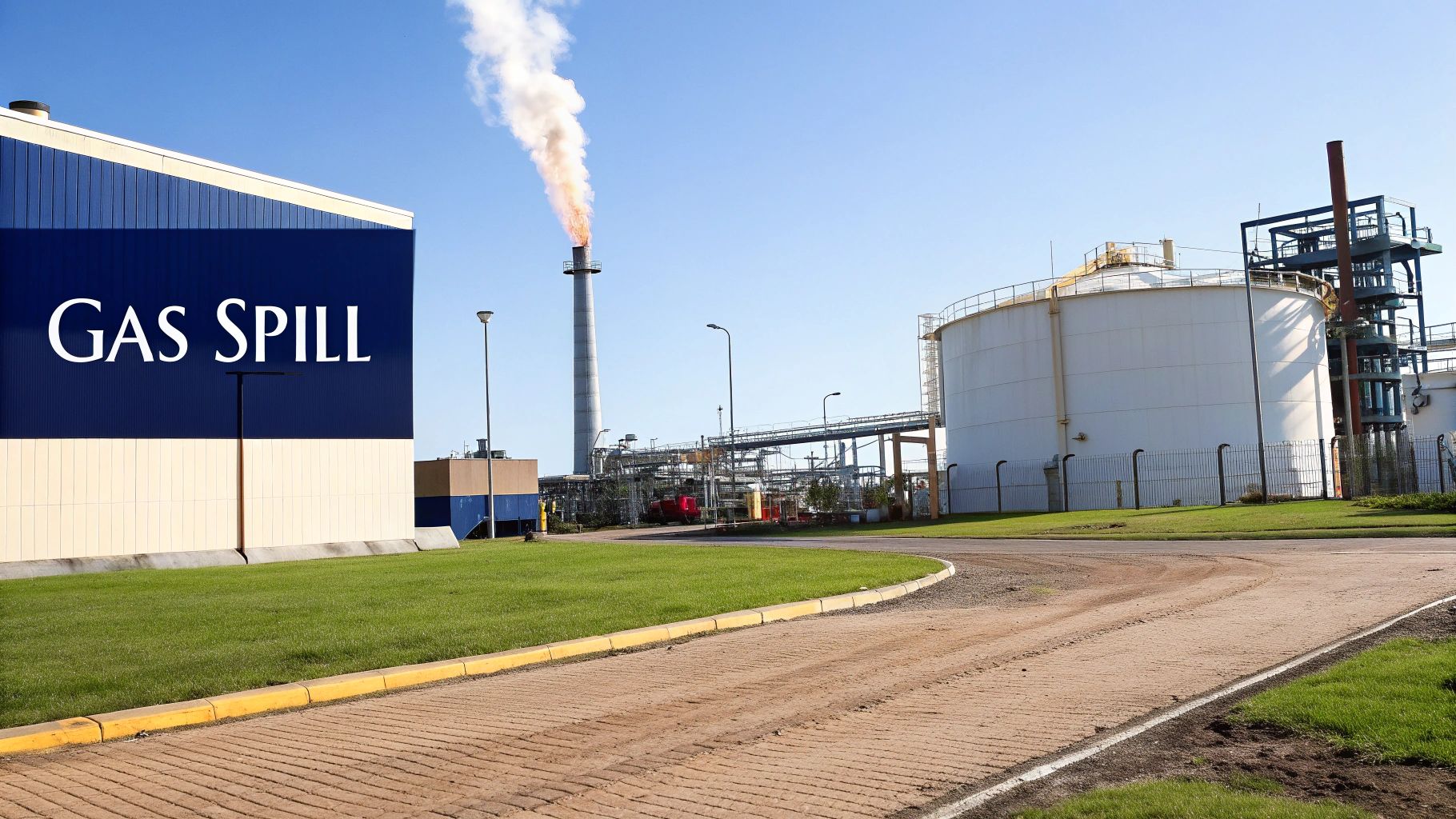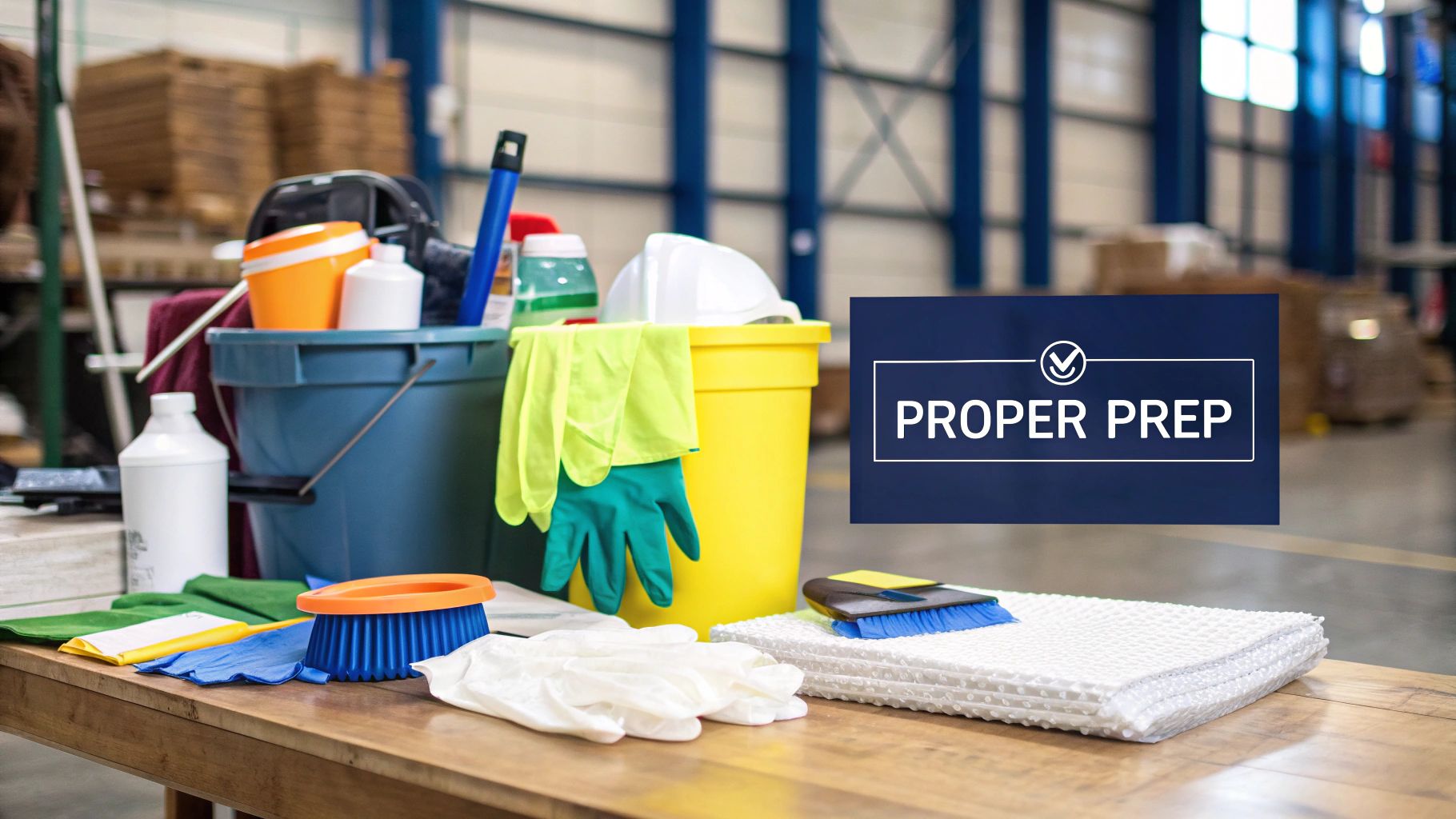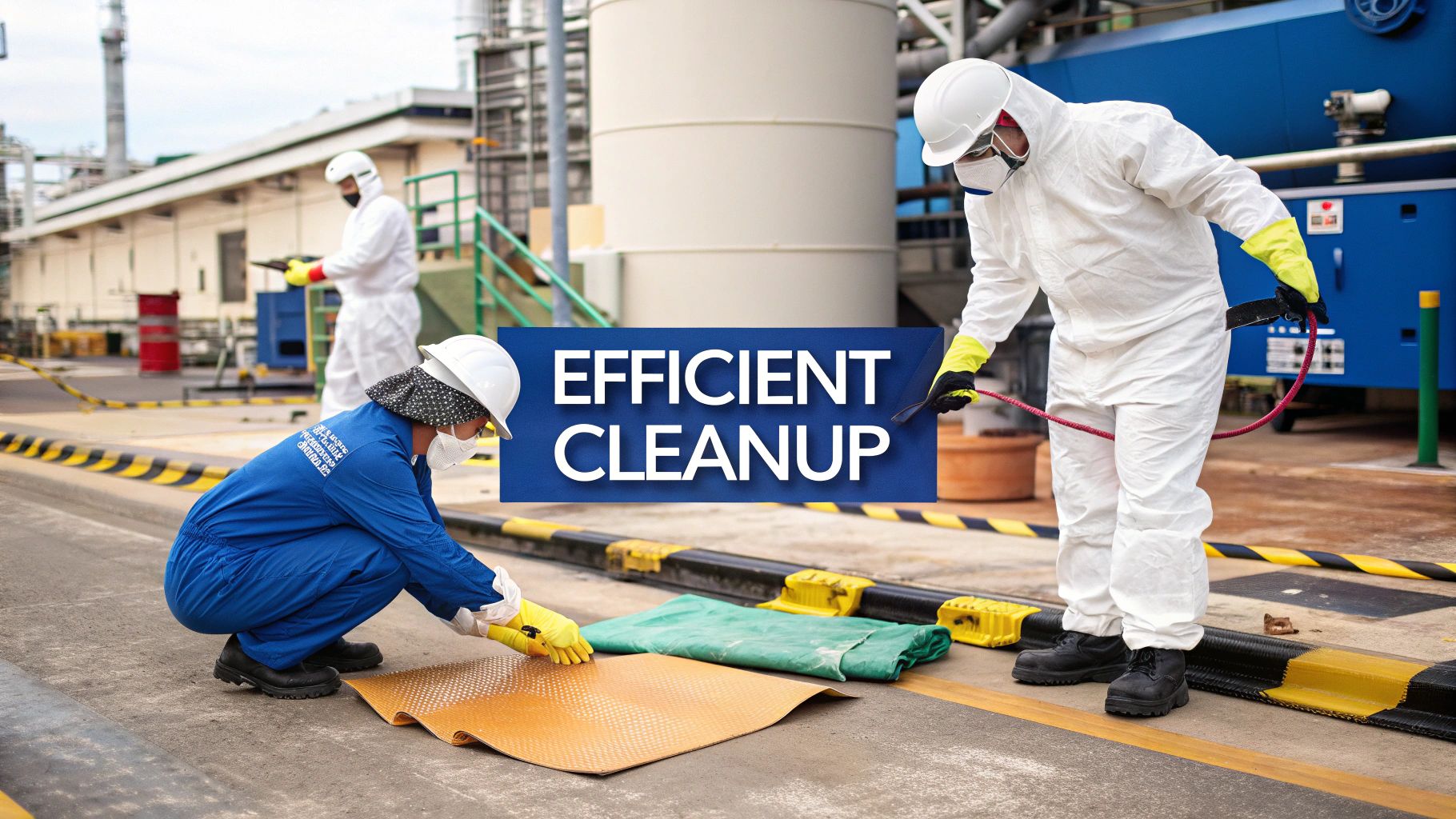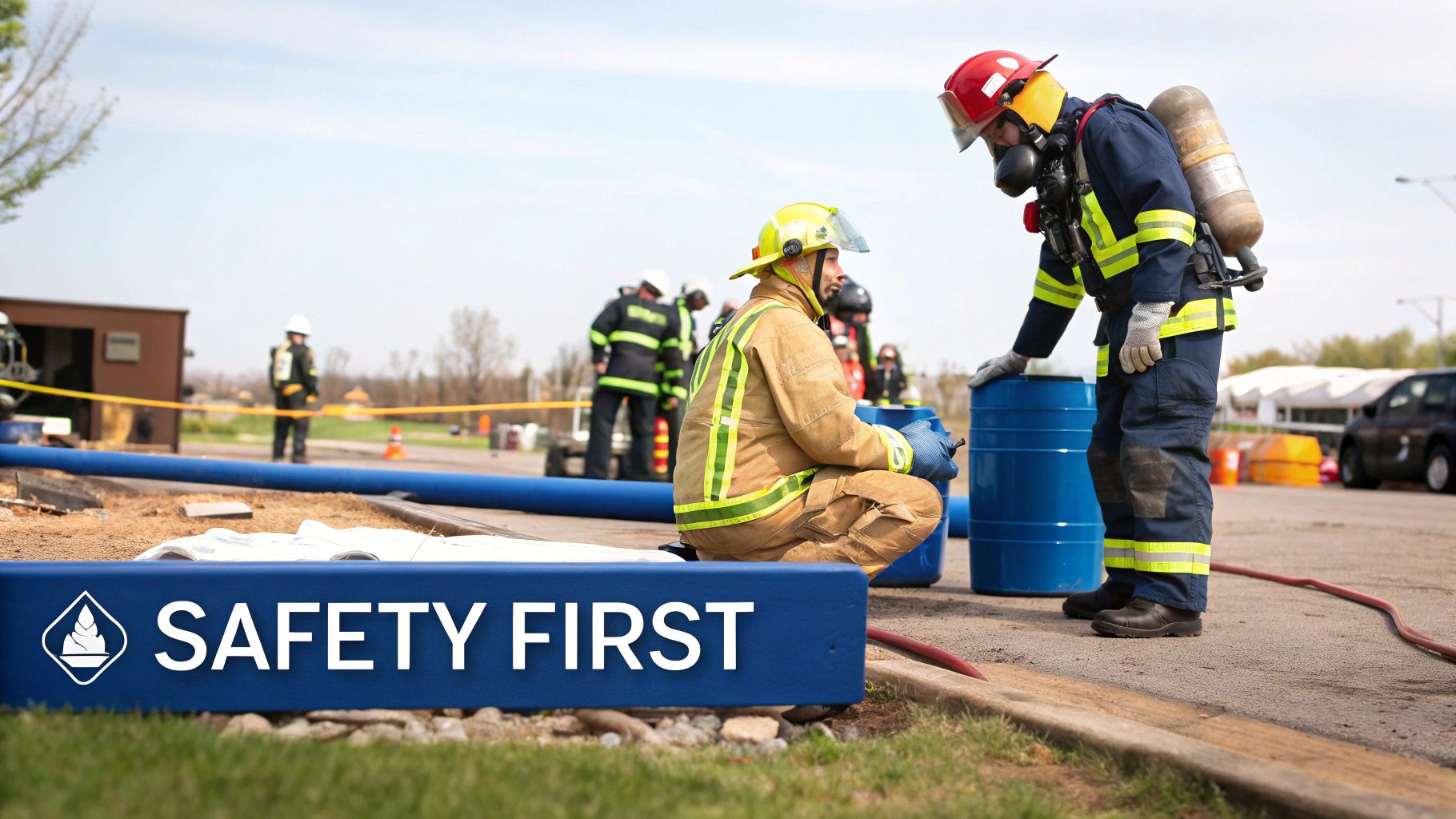The Hidden Dangers Beyond the Obvious Risks

Cleaning up a gas spill isn't as simple as wiping up a puddle. It involves mitigating a range of hazards, some obvious, others less so. While fire is an immediate concern, the less visible dangers often pose more significant long-term risks. These hidden risks, arising from gasoline's chemical makeup, can impact both human health and the environment. Understanding the full scope of the problem is essential for effective cleanup.
Immediate Hazards: A Toxic and Explosive Mix
Gasoline is highly volatile, readily evaporating at room temperature. This creates a concentrated vapor cloud easily ignited by even the smallest spark. Inhaling these vapors can also lead to various health problems, from headaches and dizziness to serious respiratory issues. Proper ventilation is therefore critical during cleanup. Even a small spill in a poorly ventilated garage, for instance, can create a dangerous accumulation of fumes.
Long-Term Consequences: Silent Threats
The dangers extend beyond the immediate aftermath. Gasoline can seep into porous materials like concrete and soil, contaminating groundwater. This contamination can linger for years, impacting local ecosystems and potentially endangering human health through contaminated drinking water. Cleaning the visible spill is only part of the solution; addressing potential soil and groundwater contamination is equally crucial. The 2020 Colonial Pipeline leak, which spilled nearly 2 million gallons of gasoline in North Carolina, highlights the sheer scale of potential contamination. More details on this incident can be found here: Learn more about this incident.
The Sneaky Spread: Beyond What You See
Gasoline's low viscosity allows it to spread quickly and penetrate seemingly solid materials. It behaves much like water poured on a sponge, rapidly absorbing and dispersing. A small spill can therefore contaminate a much larger area than is initially apparent, making thorough cleaning essential. Furthermore, the lingering odor can persist even after the visible spill is gone, serving as a constant reminder of the contamination. Eliminating this odor requires specialized cleaning techniques and products that neutralize gasoline molecules, not just mask the smell. Understanding these hidden dangers underscores the importance of proactive and comprehensive cleanup strategies.
Essential Safety Protocols Before You Begin

Before dealing with a gasoline spill, safety should be your top priority. Taking the necessary precautions can prevent a hazardous situation from becoming worse. This includes understanding the correct protective equipment, ensuring proper ventilation, and identifying potential ignition sources.
Protective Equipment: Your First Line of Defense
Selecting the right Personal Protective Equipment (PPE) is critical. This starts with nitrile gloves. Other glove materials, such as latex or standard household rubber, can be permeated by gasoline, exposing your skin to dangerous chemicals.
Eye protection, like goggles, will shield your eyes from splashes and irritating vapors. And don't forget to protect your feet by wearing closed-toe shoes.
Ventilation: Clearing the Air
Because gasoline is highly volatile, proper ventilation is essential when addressing a spill. Opening doors and windows helps dissipate fumes. However, be mindful of creating drafts that could spread the vapors further.
For indoor spills, open windows on opposite sides of the room to create a cross-breeze. In confined spaces, strategically place a fan to direct fumes away from the spill and toward open air.
Ignition Sources: Eliminating the Spark
Gasoline vapors are extremely flammable, so eliminating all potential ignition sources is paramount. This means absolutely no smoking, open flames, or sparks from electrical equipment near the spill area.
Even seemingly harmless sources, like static electricity from synthetic clothing, can ignite gasoline vapors. This highlights the importance of thorough preparation.
Over the last 50 years, pipeline spill incidents have decreased, reflecting improvements in safety procedures and stricter regulations (Explore this topic further). Despite these improvements, the risk remains, emphasizing the need for continued vigilance. You may also find this helpful: How to master...
To help illustrate the different levels of safety equipment required, let's look at the following table:
Essential Safety Equipment for Gas Spill Cleanup: A comprehensive breakdown of necessary safety equipment for different sizes of gas spills.
| Equipment Type | Small Spills (<1 quart) | Medium Spills (1-5 quarts) | Large Spills (>5 quarts) |
|---|---|---|---|
| Nitrile Gloves | Recommended | Required | Required |
| Eye Protection (Goggles/Face Shield) | Recommended | Required | Required |
| Respirator | Optional | Recommended | Required |
| Absorbent Materials | Paper towels/rags | Spill kit/absorbent pads | Professional spill kit/large-scale absorbent materials |
| Ventilation | Open windows/doors | Forced ventilation (fan) | Professional ventilation equipment |
| Fire Extinguisher (Class B) | Recommended | Required | Required |
This table provides a quick guide for choosing the right safety equipment based on the size of the spill. Remember, professional help is crucial for larger spills.
Knowing Your Limits: When to Call a Professional
While small spills can be managed safely with the right precautions, larger spills demand professional intervention. Factors such as the spill's size, location, and proximity to drains or water sources determine if professional assistance is necessary.
If you're uncertain, it's always best to err on the side of caution and contact a hazardous materials cleanup service. This proactive approach protects your health and the environment, and it can prevent potentially costly long-term damage.
Your Step-by-Step Guide to Effective Cleanup

Cleaning up a gas spill effectively involves more than just wiping up what you can see. It’s a systematic process that requires understanding how gasoline behaves, the potential risks, and the right techniques for different surfaces. This guide provides a step-by-step approach to handling gas spills safely and thoroughly.
Initial Response and Containment
The first few moments after a spill are critical. Your immediate priority should be containment to stop the spill from spreading. Begin by creating a barrier around the spill's perimeter. Absorbent materials like kitty litter or commercial spill pads work well for this. Think of it like building a dam to restrict the gasoline's flow. This initial absorption also helps reduce the release of harmful vapors.
This quick action is crucial for both safety and cleaning efficiency. Taking these steps will help make the rest of the cleanup process much smoother.
Absorption: The Core of the Cleanup Process
After containing the spill, the next step is absorbing the bulk of the gasoline. Choosing the right absorbents is key. Avoid everyday household items like paper towels or rags. These can become saturated and actually spread the gasoline. Instead, use materials specifically designed to absorb hydrocarbons, such as those found in commercial spill kits.
If a spill kit isn't readily available, materials like kitty litter, sand, or peat moss can work in a pinch. These are much better at trapping and holding gasoline, minimizing both immediate hazards and the risk of long-term contamination.
Surface-Specific Cleaning Techniques
Different surfaces require different cleaning methods. For hard, non-porous surfaces like concrete, scrubbing with a detergent solution after absorption is usually enough. Porous surfaces like asphalt or soil may require more intensive cleaning. This might involve removing and replacing the contaminated material. Carpet requires special cleaning agents and techniques to extract trapped gasoline.
For example, you might use a degreaser and a stiff brush for concrete. Soil contamination might necessitate excavation and replacement. Knowing these differences ensures effective and safe cleaning for every type of surface.
Verification and Final Steps
Even after the visible gasoline is gone, the job isn't finished. Verification is essential to ensure complete decontamination. This might involve using specialized detectors to check for lingering vapors. In some cases, consulting with professionals for a thorough assessment is a good idea. Remember, lingering gasoline poses health and environmental risks.
Proper disposal of contaminated materials is equally important. Contacting your local hazardous waste disposal services is often necessary to comply with regulations and protect the environment. Overlooking this final step can undo all your previous efforts. The EPA provides resources and guidelines for handling hazardous waste.
The U.S. Coast Guard and the EPA play key roles in responding to spills, especially larger incidents with environmental impact. These agencies, along with the National Oil and Hazardous Substances Pollution Contingency Plan (NCP), offer structured procedures and resources for effective spill response. Learn more about the EPA and Coast Guard response. This resource emphasizes the importance of understanding the correct protocols and seeking professional help when needed.
Ongoing Monitoring and Prevention
Even after a successful cleanup, especially for larger spills, ongoing monitoring is wise. Regularly check the affected area for any signs of recurring contamination, such as persistent odors or discoloration. This proactive approach helps identify and address any lingering problems. Implementing preventative measures, like storing and handling gasoline containers properly, can significantly reduce future spill risks. Taking preventative measures is the most effective way to manage the risks associated with gasoline.
The Best Products That Actually Work

Choosing the right product for cleaning gas spills is crucial. It can mean the difference between a quick, effective cleanup and a lingering, dangerous hazard. Many products are marketed as "spill solutions," but not all live up to the hype. Some may even make the problem worse. This section explores what truly works, focusing on effectiveness, safety, and environmental impact.
Commercial Absorbents: The Professional's Choice
Commercial absorbents specifically designed for hydrocarbon spills are generally a good choice. These products, often available as pads, rolls, or booms, are engineered for high absorbency. This makes them suitable for containing and soaking up larger spills.
However, these specialized products typically come with a higher cost. They can also generate a substantial amount of waste. Furthermore, some contain synthetic materials that are not environmentally friendly.
Household Alternatives: Effective and Affordable
Believe it or not, many common household materials offer surprisingly effective gas spill cleanup. Kitty litter, thanks to its clay composition, is excellent at absorbing gasoline. Sand and peat moss also work well to absorb spills and prevent them from spreading.
These readily available alternatives are cost-effective and often easier to access than commercial products. This makes them a convenient option for quick cleanups.
Natural vs. Synthetic: Weighing the Options
The choice between natural and synthetic absorbents involves more than just cost and convenience. Natural absorbents, like kitty litter, sand, and peat moss, generally break down more easily. This reduces their long-term environmental impact.
However, natural options may not absorb as much liquid per unit volume as some synthetic alternatives. This means you might need to use a larger quantity. Synthetic absorbents, on the other hand, boast higher absorbency but can pose environmental concerns due to their composition and disposal requirements.
CLiX Fueling Solutions and similar products offer another approach: preventing spills in the first place.
Product Application Techniques: Getting the Most Out of Your Absorbent
No matter what product you choose, the key to effective cleanup lies in proper application. Always start by containing the spill. Think of building a dam to prevent the gasoline from spreading.
Then, apply the absorbent from the outer edges of the spill inward. This pushes the gasoline towards the center, preventing further expansion and simplifying cleanup. For larger spills, consider layering different absorbents. Start with a coarse material like kitty litter for the bulk of the liquid, then use finer absorbents for any remaining traces.
Expected Outcomes and Safety Precautions: Protecting Yourself and the Environment
Proper ventilation is critical during any gas spill cleanup. Gasoline vapors are harmful and flammable, creating a fire hazard. Always wear nitrile gloves to protect your skin. Never use household rubber gloves, as gasoline can easily permeate them.
Dispose of contaminated materials responsibly. This often involves contacting your local hazardous waste disposal services. Understanding these safety protocols and expected outcomes is crucial for a safe and effective cleanup.
To help you choose the right product, we've compiled a comparison table:
Gas Spill Cleanup Products Comparison: Comparison of effectiveness, cost, and environmental impact of various products for cleaning gas spills
| Product Type | Effectiveness | Cost Range | Environmental Impact | Best For |
|---|---|---|---|---|
| Commercial Spill Pads | High | High | Moderate | Larger spills, professional use |
| Kitty Litter | Moderate | Low | Low | Small to medium spills, readily available |
| Sand | Moderate | Low | Low | Small spills, outdoor use |
| Peat Moss | Moderate | Low | Low | Small spills, outdoor use |
This table summarizes the key characteristics of different spill cleanup products. It highlights the trade-offs between effectiveness, cost, and environmental impact. Consider your specific needs and circumstances when making your decision. Remember, safety should always be your top priority. Follow all recommended precautions during the cleanup process.
Surface-Specific Cleaning Techniques That Work
Cleaning up a spilled gas isn't as simple as it might seem. The best way to clean it depends on what surface you're dealing with. Gasoline reacts differently with porous materials like concrete than it does with absorbent ones like carpet or soil. Knowing these differences is key to cleaning effectively and preventing long-term issues.
Concrete and Other Hard Surfaces: A Deep Clean Approach
Concrete is porous. This means it absorbs gasoline, making the cleanup more difficult than a simple wipe. After soaking up the initial spill with materials like kitty litter or commercial absorbents, you'll need a deep clean. This involves scrubbing the area with a strong detergent solution and a stiff brush, much like cleaning a greasy pan. Scrubbing helps dislodge the gasoline trapped inside the concrete's pores. Finally, rinse thoroughly to remove any leftover detergent and gasoline.
Carpet and Upholstery: Specialized Cleaning Is Key
Carpet fibers trap gasoline, causing lingering odors and potential health risks. Regular cleaning methods often don't work and might even make things worse by spreading the gasoline. For carpets and upholstery, you'll need specialized cleaning agents made for hydrocarbon spills. These products break down gasoline molecules, making them easier to remove. Extraction machines, often used by professional carpet cleaners, are very effective at getting rid of gasoline and cleaning agent residue from carpet fibers. This thorough cleaning is crucial for preventing lingering smells and ensuring the area is truly clean.
Soil: Addressing the Hidden Contamination
Gas spills on soil are a serious environmental problem. Gasoline can seep into the ground and contaminate groundwater, harming the local ecosystem. Cleaning gas-contaminated soil often requires removing and replacing the affected area, like removing a diseased part of a plant. How much soil you remove depends on how big the spill was and how permeable the soil is. Sometimes, more specialized techniques like bioremediation are necessary. Bioremediation uses microorganisms to break down the gasoline in the soil.
Eliminating Gasoline Odors: Neutralizing the Smell
One of the toughest parts of dealing with gas spills is the lingering odor. Covering it up with air fresheners isn't a solution and can even be dangerous because it doesn't fix the contamination. To get rid of the smell, you need to neutralize the gasoline molecules, not mask them. Products with oxidizing agents can break down the odor-causing compounds. Good ventilation during and after cleaning is also important to help clear out any remaining vapors. For more helpful tips and resources, check out our guide on fueling solutions.
Hazardous material spills, including gasoline, are a major concern, and there's ongoing research focused on better prevention and cleanup. A study in Texas looked at highway spills and highlighted the need for effective containment strategies and improved emergency response plans. Discover more insights about this topic. These findings show how complex cleaning up gas spills can be and why it's so important to use the right techniques for each surface.
When DIY Won't Cut It: Professional Intervention
Knowing when a gas spill is beyond your capabilities is a crucial safety decision. This section offers expert guidelines to help you recognize when professional help is essential. We'll explore the key factors indicating this need and guide you through the process of finding the right professionals.
Recognizing The Need For Professional Help
Several factors signal the need for professional intervention after a gas spill. Spill size is a primary consideration. Small spills, like those from a lawnmower, might be manageable, but spills larger than a few quarts likely require professional attention.
Location complexity is another important factor. Spills near drains, water sources, or porous surfaces like concrete or soil often demand professional cleaning because of the increased risk of contamination.
Finally, environmental sensitivity is paramount. Spills in environmentally sensitive areas, like waterways or protected habitats, require expert remediation to minimize ecological damage.
For instance, a small spill on a paved driveway might be handled with household absorbents. However, a similar spill on grass near a storm drain necessitates professional help due to potential soil and water contamination. Assessing the context of the spill is as crucial as the spill size itself.
Engaging The Right Professionals: A Step-by-Step Guide
When you've determined you need professional assistance, contacting the appropriate authorities is the first step. This might include your local fire department, environmental agency (Environmental Protection Agency), or a hazardous materials cleanup service.
Providing accurate details when reporting is vital. Include the location, estimated spill size, fuel type (gasoline, diesel), and any potential environmental impacts. This information helps responders effectively assess the situation and bring the right equipment.
After contacting authorities, prepare for the professional remediation process. This usually involves securing the area to prevent further spreading and containing the spilled fuel using specialized absorbents and equipment. Professionals also address any environmental damage, including soil and water remediation. This thorough decontamination ensures the area is safe.
Costs, Insurance, And Legal Considerations
Professional gas spill cleanup involves costs that vary based on the spill's size, location, and required remediation. While an unplanned expense, understanding your insurance coverage is important. Some homeowner's or business insurance policies might cover these costs. Review your policy details to understand coverage limits and requirements.
Moreover, certain spills may trigger legal reporting requirements, varying by location and spill size. Ensuring compliance is essential to avoid fines and liability. This often involves documenting the spill, reporting it to authorities, and cooperating with any investigations. Professional remediation services can often assist with these legal obligations, ensuring you meet all requirements.
CLiX Fueling Solutions helps prevent spills before they happen. Their system automatically stops the fuel nozzle when your tank is full, eliminating overfilling and spills. Learn more about protecting your boat and the environment: CLiX Fueling Solutions











